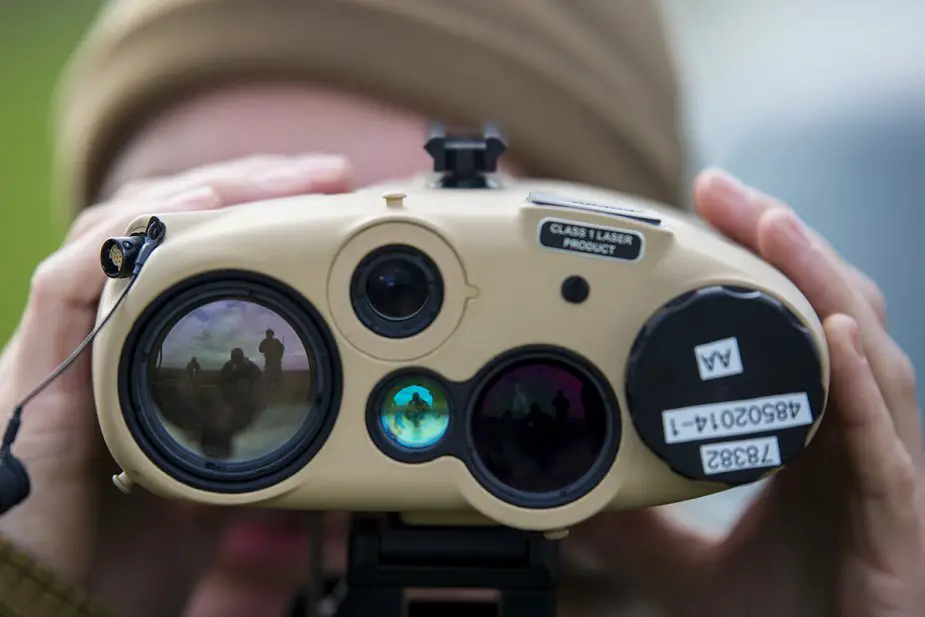Enhancements underway for USMC handheld targeting system
The U.S. Marine Corps is integrating new technologies into an existing handheld GPS targeting system that helps Marines locate adversaries on the battlefield. Matt Gonzales, MCSC Office of Public Affairs and Communication, Marine Corps Systems Command, explains.

A U.S. Marine with Special Purpose Marine Air-Ground Task Force-Crisis Response-Africa 19.1, Marine Forces Europe and Africa, uses a Common Laser Range Finder-Integrated Capability system to locate notional targets during a close-air-support training event with the British Royal Air Force at Holbeach Range, England, Feb. 20, 2019. Fielded in 2017, the Corps plans to integrate new features into the CLRF-IC to enhance its effectiveness on the battlefield. (U.S. Marine Corps photo by Sgt. Katelyn Hunter)
Fielded in 2017, the Common Laser Range Finder-Integrated Capability is a handheld target location system that uses an eye-safe laser range finder and algorithms to determine a target’s location. It then transmits that location to the Advanced Field Artillery Tactical Data System or another fire support system.
U.S. Marine Corps Systems Command’s Ground Combat Element Systems began an in-production engineering change proposal—or ECP—process to integrate an enhanced digital magnetic capability into the CLRF-IC. The configuration change will reduce the amount of time and movement required by Marines when using the system. “Previously, the magnetic effects of an environment would cause the operator to go through a series of sitting and standing, stepping to the left and to the right in order to calibrate the system,” said Jeff Nebel, MCSC’s Fire Support Coordination team lead. “What we’re integrating is a new digital magnetic compass so the operator can calibrate the system basically the same way you do your cellphone—just rotate it left to right, and up and down a few times.”
MCSC is also integrating a capability to export video or still-pictures from the CLRF-IC to a target handoff system, enabling Marines to transmit photographs of targets to Marine Corps headquarters, which could help identify enemies. “We did an in-production ECP, and we’ll begin fielding the enhanced CLRF-IC system in the next couple of months,” said Nebel.
The first enhanced CLRF-IC devices are slated to field later this year, and Nebel projects the system will reach Full Operational Capability by early 2021. “We took a short pause from our fielding so we could incorporate the in-production ECP, and that pushed back our FOC,” said Nebel. “But now we’re going to be able to get a more capable system out to Marines.”
CLRF-IC popular among Marines
The original CLRF system fielded in 2012. Back then, the system incorporated the common laser range finder and a thermal laser spot imager. Five years later, an updated, lightweight version—the CLRF-IC—was introduced to Marines.
Feedback on the CLRF-IC from Marines has been positive, Nebel said. “Most of the Marines like how light the system is,” said Nebel. “It’s significantly lighter than the previous system.”
Paul Knight, lead systems engineer for the CLRF-IC, echoed Nebel’s sentiments. A lighter system reduces the amount of weight the Marine Air-Ground Task Force must carry on the battlefield, Knight said, which allows them to haul additional gear if necessary. “If you’re subtracting weight in one place, that means Marines can carry extra gear that previously would have overburdened them,” said Knight. “The CLRF-IC reduces that weight significantly.”
The CLRF-IC also transmits information faster than the original version, said Knight. It features day and night cameras, a rangefinder and celestial positioning precision so Marines can use the system in various weather conditions.



















